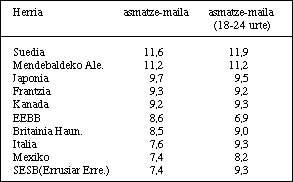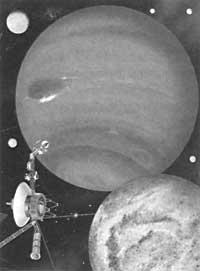Forest of Viet Nam
1989/02/01 Kemf, E. Iturria: Elhuyar aldizkaria
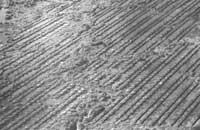
At the moment when the world's tree masses disappear at a dizzying speed, one of the world's poorest nations, with the highest population density, is a pioneer in the revegetation of the rainforest. After twelve years of experimentation, often years of failure, Vietnamese scientists have begun to reconvert war-torn forests in this country (forests damaged in 30 years by continuing plague).
The main proof that the reforestation of the Viet Nam tropical forest is underway is that they are located about 100 kilometers northeast of Ho Txi Minh City, on the edge of the 30,000 hectare land. The Ma Da bushes, covered by the first humid tropical forest, were the fortress of the North Vietnamese soldiers. To drive the soldiers out of the forest, South Vietnamese and American troops burned napalmas in a wooded area. As a result, three-quarters of the trees were removed and the landscape looked like an arid savannah and a crushed, bombed hillside, called American grass by the Vietnamese.
After the war in 1975, Vietnamese scientists began to replant several species of native trees. These trees were destroyed by 72 million liters of herbicide thrown in 1.7 million hectares during the bombing of South Vietnam. These initial trials were unsuccessful, especially because they were burned in fires due to heat during the dry season. To protect young trees from this warm tropical sun, scientists covered the forest with exotic trees such as Indigofera tenesmani, Acacia auriculiformis or Cassia siame. When these trees grew a lot, several species of dipteroarp were planted.
After more than ten years of experimentation, scientists were happy with the survival of some species. Currently, the 300 hectares of eucalyptus and arquacia protect four species of Dipterocarpus: D. alatus, (called yang), D. Dyeria, (dau), D. hopeadorata and D. anisoptera.
The experiment offers other countries around the world great hope for reforestation of tropical forests, but it also highlights the time and difficulty of reconfiguring tropical forests. The Vietnamese have taken more than ten years for a few species to adhere to a place where thousands of species have remained hundreds of years. In addition, the part that is being covered in the forest of Ma Da and the adjoining nursery (which accounts for 1% of the original forest) is only a piece of green on the edge of the bare slopes. Vietnamese scientists believe it will take decades to regenerate other plant species and question the return of large mammals such as elephants, tiger, bears or deer that lived in the forest.
In Viet Nam more forests have been lost than in wartime since the end of the war in 1975 until today. Due to the reconstruction of ten million homes, schools, hospitals, roads and irrigation systems after the war, the collection of wood for fire, forest fires and the method of cutting and burning that has lasted for centuries in agriculture, Viet Nam lost every year about 200,000 hectares of forests. 40 percent of the country or, at present, is considered poor.
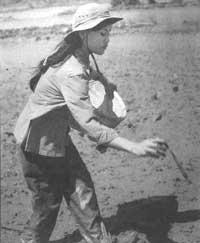
However, two years ago, in a reduced budget for the environment, around 500 million trees were planted on 160,000 hectares of Viet Nam. The Vietnamese prioritize the regeneration of the environment, despite the strong economic crisis and the poor collaboration they receive from external nations. 4 billion dollars from the Soviet Union and 50 million dollars from Sweden.
Compared to a state like Costa Rica, it receives millions of dollars each year from foreign states for the aid of the environment and each year mounts only 7,000 hectares of trees to compensate for the loss of 50,000 hectares; the revegetation test of Viet Nam is perhaps the most expensive in the world.
Vo Kui, Dean Biologist at Hanoi University: Viet Nam's goal is to plant 200,000 hectares of trees this year and reach 300,000 as soon as possible. The role of revegetation is the biggest national challenge from unity.
During the war, Vo Kui and a group of unassembled scientists crossed the cruise area near the 17th parallel, risking his life, to analyze the effects of war on the environment. It was immediately after the defoliation bombings carried out by American and South Vietnamese troops. This first visit showed them their role. Vo Kui and a group of Vietnamese scientists drafted a national plan for the nation to regain its ecological status.
The Plan, based on the principles of the World Conservation Measures, presented in 1980, claimed two measures to be implemented immediately: a program of high orientation to family planning and a massive campaign of forest recovery. Vo Kui and its inhabitants, including General Vo Nguien Giap (former commander of the North Viet Nam), published a national plan of measures similar to the previous environmental restoration document, prepared before 30 other countries did.
A few months ago we talked about Hanoi, General Giap said: The soldier now comes to another front, the environmental front. I come from the military front to the technological and scientific front, to the regeneration of the environment.
After the war, I did not realize the importance of conservation, but without restoring the environment, I am clear that Viet Nam cannot have an economic recovery, because both are inseparable.
General Giap, Vice Presidents of Viet Nam and Environmental Protectors of the highest national level, E.F. Schumacher, author of the book Smal is Beautiful, acknowledged that it affected his thinking. My new strategy is not only a measure for the environment, but also a measure for peace. Now I'm bored by the Viet Nam environment and peace.
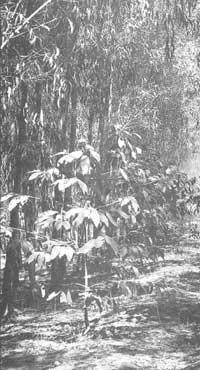
Today, it has not been 3 years since Viet Nam published its strategy, millions of peasants are filling about 25 million bomb-driven craters, some of them 30 meters wide. They are being covered with crops and in some areas craters have become fish farms. Citizens returning to land have replanted trees on the roadsides of the entire nation. Nearby, surrounded by corrosive metal plates, you can see landscaped plots and sentinels in rusty tanks next to freshly planted fruit trees. Bomb-driven craters have left the rice fields perforated and the empty caps of the pumps are scattered across the ground.
Farmers and their children, as they do with wood, are grouped into large groups. Women pick them up in large baskets and place the rusty metal at the end of the long rods to the nearest chatarrería along kilometers. From there they are transported to the factories and used there to make furniture or sell them, etc. Near the seventeenth parallel, the line that divided the nation until its union in 1975, called the McNamara barrier, was demolished by schoolchildren and children and planted a row of trees in the place where the barrier was located. The fence was thus named by soldiers and journalists in memory of Robert McNamara, American defense secretary during the war. On the boundary between both sections it was in a demilitated area and its length exceeded 100 kilometers.
At the Kon Tien Forestry School in the province of Binh Tri Thien, a few kilometers from the demilitated area, students have planted and cared for over a million trees over the past six years.
The Minister of Forestry of Viet Nam has planned for the next 10 years the introduction of 1.5 million hectares of destroyed forests and the restoration of another 200,000 hectares. In addition, the Ministry of Education has included tree planting as an activity in the curriculum. Each student must plant and care for the trees. The Ministry of Education has assigned an annual tree to elementary school, middle school, and final school students. In 1985 and 1986 Vietnamese students planted 52 million trees and prepared 860,000 square meters for nurseries.
We have to work fast,
said Vo Kui. If we fail to increase the percentage of current revegetation from 21% to 50%, Vietnam is in full environmental crisis.
Any task is unavoidable. According to Vietnamese scientists, the bombing, cleaning of the forest by machines, napalma and defoliation of American and South Vietnamese troops led to the loss of 2.2 million hectares of forests and agricultural land. In the south, the forests of the plateau suffered a waste of 5.6 million hectares. In addition, 135,000 hectares of rubber plantations, 300,000 million tons of food and fauna and valuable fish farms have been destroyed.
U.S. air forces, in the so-called “Operation Ranch Hand,” dispersed 40 million liters of Agent Orange, 20 million liters of Agent White and 8 million liters of Blue Agents in crops, forests and wooded masses in a huge environmental massacre. Agent Orange has very toxic dioxin (2, 3, 7, 8-TCDD), currently totally prohibited. From 1961 to 1971 the South Viet Nam dispersed at least 35% of the total, and remains today (18-25 years after the last attack).
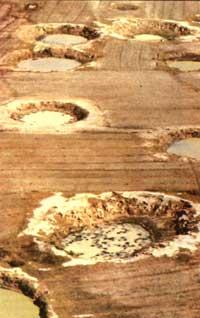
In the opinion of the pioneers in this matter (in the Arnold Screter of the University of New York, Bignhamton and John Constable, belonging to the Harvard School of Medicine), the vegetative component of Agent Orange, TCDD, can still be found at high doses in the soil, food and fauna of southern Viet Nam. According to the study conducted by these experts, the fatty tissue analyzed in South Viet Nam and breast milk continue to contain dioxin.
Schecter says: Although CDD contamination can be detected in the animal tissue of Viet Nam (although not entirely contaminated in part by Agent Orange) there is contamination by other polychlorinated dibenzodioxins and polychlorinated dibenzofurans, similar to that discovered in human tissue in the same period. This means that dioxin contamination from other sources can contaminate the food chain from both wild and rural sources.
If we look from the helicopter south of Viet Nam, we can observe the damage that the war has caused in the environment. The remains of the bombing craters appear in lines parallel to the runways that extend into the rice fields, often turning half or one-third of the rural area into flooded areas. When the helicopter stood less than 300 meters from the ground, I could see the peasants picking up the rice between the holes. But in Tai Ninh province, looking at the so-called Boi Loi woodlot, the landscape seemed dead.
The Boi Loi bushes, with about 3,000 hectares and which was refuge of Viet Kong during the war, were bombed, abandoned without leaves, burned with napoles and excavated with ploughs 3 meters wide and 2.5 tons of weight. Almost 20 years later, only the trunks of the cut trees appear in the dry meadows. Vietnamese scientists call these areas of destruction Agent Orange museums.
The Mekong Delta seems to have better air watching. Viet Nam's excellent mangrove network, the most affected ecosystem by the U.S.-Viet Nam war, is in a more advanced restoration situation than national tropical forests. South of Ho Txi Minh City, in Rung Sat, since its beginning of reforms in 1976, four mangrove forestry companies have been installed near the American naval base of the Nga Bai.
Due to the start of revegetation work 9 years ago, mangroves currently produce the fuel needed for maintenance and use by Ho Txi Minh residents. As I passed through the Rung Sat high, in January, in kilometers and kilometers I saw planted rows of bushes, in the areas steep by Agent Orange to become mud.
The largest mangrove forest in Viet Nam will take longer to recover. At 1,600 kilometers south of the 17th parallel or, at the end of the nation, the area presiding over Kamau was the scene of some of the hardest attacks of the war and one of the points that suffered the defoliation. More than 50 percent of the productive bushes and fish farms were completely destroyed, often with a simple dose of Agent Orange.
In total, defoliation and napalma destroyed 124,000 hectares of mangrove in southern and central Viet Nam. With the herbicides the forty species of mangroves disappeared, along with the hardest nipa palm. Thousands of wildlife species had to suffer harmful effects like millions of people. Twenty years later, after the terrible work of revegetation, most people and some species of birds have returned.

Rhizophora spiculata
the main mangrove species, which supplies wood, straw, charcoal and tannin to its residents, was the most affected by defoliation. During the war, the South Vietnamese soldiers and their inhabitants, besieged by the Viet Kong, had to resort to the fruity of the mangroves at the end of the rice. The leaves of different species were useful for feeding domestic animals and fertilizing rice plantations. When the mangrove blooms, the bees feed in the coplos, feeding their inhabitants of wax and honey. In addition, Rhizophora broad leaves are an important element in the seafood food chain. The fallen leaves are dissolved in the canals, adding nutrients to the water to which the aquatic species reproduce and feed.
After spraying, Rhizophora has not recovered much. In 1984, the Vietnamese introduced 32,000 hectares in the Camaio in Rhizophora, but strong monsoon winds and coastal floods have destroyed.
Despite these delays, the Vietnamese have faced their problems with courage. One of the main innovations carried out last year was the integration of fish and forest resources in the same department. The Government is also thinking of setting up a research centre for the Mekong mangrove Deltan and conducting agricultural and forestry trials. Led by Vo-Tong Xuan (professor of agronomy and vice-rector of Kantho University), in Mekong Delta they have introduced in thousands of hectares diverse plant varieties using agricultural and forestry techniques.
In recent years we have conducted extensive studies on peasant experiences in Delta lands
says Vo-Tong. In areas left without leaves or in areas burned by fires, farmers pull back from trees, hit the land and plant pumpkins. In the next season they plant different types of beans, rice, corn, sesame, banana, sweet potatoes, etc. At the same time different mangrove species are being introduced.
A decade ago some American scientists analyzed that mangroves are able to restore them naturally for 20-30 years. Arthur Westing, a member of America's first scientific research team, was less optimistic at the 1970 visit to Viet Nam to analyze the consequences of the war on the environment. According to him, the regeneration of the forest will take more than fifty years to be carried out through a continuous planting.
Currently, more than 20 percent of mangrove plantations on the Kaman peninsula remain arid. These destroyed plots, also called Agent Orange museums, are observed in many places throughout the peninsula. These places, covered in shaded waters, are distorted by unnatural forms of the arboreal rear that are ejected into sterile swamps.
Nor has nearly 30 percent of the mangroves in the rear (malaleuka-baso) been restored. One of the main difficulties in restoring the forests of malaleukas (sprayed with Agentea Orange and bombed with napalma) is the barren grass that has grown there after cutting down the trees. According to Ngueien Van Nam, head of forestry in the province of Mihtn Hai, 26,000 hectares of mallets were completely destroyed and another 60,000 hectares were affected. With the help of hundreds of workers, scientists have successfully introduced 20,000 hectares of blisters. Nam believes that Vasamutiles will have to spend between 20 and 30 years to pour malaleukas. Consider that the territories that are not yet cultivated will not give products for the premises until 2020.
Viet Nam has made significant progress in reforestation work, but regeneration of the environment has been hampered by lack of money. Last winter Sweden contributed about $100,000 for the first phase of environmental regeneration projects. The Swedish Authority for International Development is studying the $750,000 increase in reform works that will begin in 1989. Projects can be considered as the starting point for other States to start collaborating on the restoration of Viet Nami. However, if Viet Nam does not withdraw its troops from Kamputxea, it risks losing Swedish aid. Some governments, including Sweden, have said that since 1990 they will not help unless they withdraw their troops from Kamputxea.
Until May last year, aid groups outside the government were required to ask the Minister of Finance for permission every time they had to donate to Viet Nam. However, recently established standards allow support groups to direct their exports for a year “to meet their health, food, clothing, home and education needs.”
After a group of representatives of Vietnamese scientists visited the United States in 1987, American support agencies praised the demise of control in donations to Viet Nam and Kamputxa. According to Irene Santiago, Director of Oxfam America for Southeast Asia, Vietnamese people have the ability to help themselves. They have shown that they have skill, scientific knowledge, experience and responsibility in dealing with their problems. In case Oxfam American intends to help Viet Nam, it welcomes the American Government's new decision not to apply rules to the States that were embarked, including Viet Nam and Kamputxea.
General Giap, who wrote the introduction of the National Conservation Measures, recognizes that Viet Nam needs external help, but is hopeful. It says: These measures are quite alarmist, but not pessimistic. Serious environmental problems are insurmountable. The resource base can be reformed and the Vietnamese have the courage, discipline and initiative to address these problems, as they have successfully faced liberation and unity.

Gai honi buruzko eduki gehiago
Elhuyarrek garatutako teknologia



